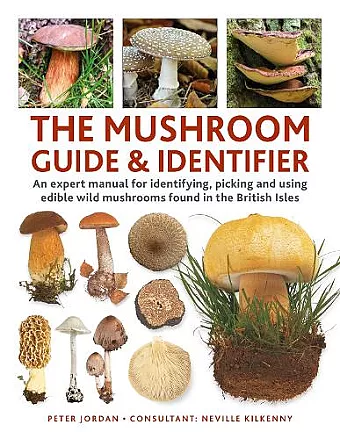The Mushroom Guide & Identifer
An expert manual for identifying, picking and using edible wild mushrooms found in the British Isles
Peter Jordan author Neville Kilkenny author
Format:Hardback
Publisher:Anness Publishing
Published:1st Feb '24
Should be back in stock very soon

FINALIST IN GOURMAND WORLD COOKBOOK AWARDS 'MUSHROOMS' 2024 It is crucial that the most expert advice is taken when hunting for mushrooms, and this authoritative new handbook offers clear, practical information for accurate identification. A clear introduction explains everything a mushroom picker needs to know, followed by a fully-illustrated guide of the most popular edible wild mushrooms, with storage and cooking tips. Their identifying features and typical habitats are described. In addition the book presents and describes the poisonous and potentially deceptive species which the mushroom picker is most likely to come across.
Mushrooms are fascinating for so many reasons, but not the least of them is that you can eat many of them with relish but if you eat some of them they may constitute your last meal. And so a book nudging you towards picking and using mushrooms has to be pretty strong on the warnings and clear on the identification features. I'm no expert (which is why foraging for fungi seems an exotic and exciting prospect to me) but it seems to me that this book gets the balance between encouragement and caution right. It is a very attractive book thanks to the inherent weirdness and beauty of the mushrooms and maximised by very clean and clear page layouts. You don't have to be planning to scoff self-gathered mushrooms to find this book attractive and interesting. However, if that is your plan, then the page 'Safe Mushrooming' has enough stern warnings to instil caution into any but the most foolhardy. If I were to take up foraging for mushrooms I would read that page of this book every time I went out into the field with its chilling last sentence 'Always keep a specimen back, so that you have something to take with you to hospital for a mycologist to identify'. It's not even as though there are two types of mushroom from the point of view of danger - the safe and the lethal. No, there are mushrooms that are yummy, some that are edible but don't taste good, some which will give you stomach upsets if you don't cook them properly and others to which some of us are allergic but others are not not. There are some great names for these species and in the section on poisonous mushrooms there are five species with helpfully off-putting names (though they all look rather attractive and mild to me), namely: Sickener, Poisonpie, Deadly Fibrecap, Deadly Webcap and Funeral Bell (possibly the most attractive of those five). The accounts of edible and poisonous species are kept separate but flicking through them the baddies look as attractive as the goodies (and why wouldn't they?). This is probably true of people too, except in old western films where you can make a pretty accurate assessment of the moral fibre of the male characters by the colour of their hat, shirt and horse and by whether or not they appear to have shaved and washed recently. Such an approach won't work with mushrooms and you may have to resort to making spore prints to be certain of identification. Few people writing about their favourite aspect of natural history have the difficult task of trying to enthuse people while warning them too. No-one has to write 'Marsh Tits make charming companions in the field but the very similar Willow Tit might peck your arm off so be sure to learn their calls properly and avoid any individuals about which you are not sure'. This book seems to get the balance right and I'm sure (because I can feel it myself) some will be drawn to the subject partly because of, rather than in spite of, the danger. I enjoyed this book very much because mushrooms are so weird and so beautiful but also because it has to deal with the tricky issue of poisoning in a responsible and clear manner. This book has Peter Jordan's original text updated by Neville Kilkenny. The cover? Just right, I'd give it 9/10. Mark Avery, Standing up for Nature, March 2024; If you enjoy finding food in the wild, then The Mushroom Guide and Identifier is the essential book for safe picking. This book is full of expert advice for identifying and using edible wild mushrooms found in the British Isles. So many mushrooms are delicious and safe to eat but it is crucial that one can recognise those which will do you no good at all - and others that might, if consumed, bring on a nasty dose of premature mortality. The Mushroom Guide and Identifier by Peter Jordan and Neville Kilkenny is a fully illustrated manual to enable to forager to select the best natural, organic, healthy and delicious mushrooms. Their identifying features and typical habitats are described. In addition, the book presents and illustrates the poisonous and potentially deceptive species which the mushroom picker is most likely to come across. The Mushroom Guide and Identifier is perfectly sized for taking on hikes and woodland walks. It would make a lovely gift for those who enjoy fresh air with the prospect of a tasty and free lunch at the end. Chrissie Walker, Mostly Food, March 2024
ISBN: 9780754835332
Dimensions: unknown
Weight: unknown
160 pages